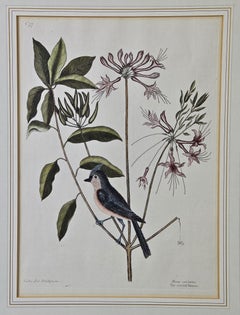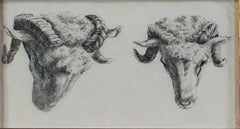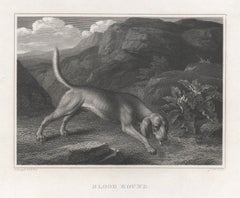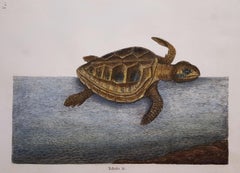Mark Catesby Art
English, 1682-1749
Mark Catesby (24 March 1683 – 23 December 1749) was an English naturalist. Between 1729 and 1747 Catesby published his Natural History of Carolina, Florida and the Bahama Islands, the first published account of the flora and fauna of North America. It included 220 plates of birds, reptiles, amphibians, fish, insects, mammals and plants. Mark Catesby's The Natural History of Carolina, Florida and the Bahama Islands is generally credited as the first published work to provide illustrations and descriptions of North American flora and fauna. From 1722-1726 Catesby, an English naturalist, ranged over South Carolina, Georgia and the Bahamas sketching and collecting specimens of native plants and animals. Little is known of Catesby's early life. He was born in eastern England in 1683. Although Catesby does not appear to have attended university or studied for the Bar, he was sufficiently educated to write clear English and Latin. His interest in and knowledge of plants may have derived from his uncle, who maintained a botanical garden. Catesby also appears to have benefited from an acquaintance with John Ray, a leading English naturalist of the 17th century and the co-author of an early classic study of birds. It is unclear when or how Catesby developed his skills as an artist.
Catesby's first visit to North America occurred in 1712 when he traveled to Williamsburg, Virginia, to live with his sister and her husband, who had settled there. During his seven-year stay, he explored the length of the James River sketching plants and collecting botanical samples. Upon Catesby's return to England in 1719, his work in Virginia drew the attention of several influential members of the Royal Society. And with their financial backing, Catesby returned to North America three years later, arriving in Charleston in May 1722. During his four-year stay, he traveled throughout South Carolina, coastal Georgia and to the Bahamas. The sketches and specimens Catesby gathered during his second North American trip formed the basis for The Natural History of Carolina, Florida and the Bahama Islands. Although most often found as a two-volume set, Catesby's Natural History was published in 11 discrete sections from 1734-1747 and sold by subscription. Although Catesby died in 1749, his work was republished in 1754 and again in 1771. Catesby's work predated the classification system developed by Swedish botanist Carl Linneaus. However, the 1771 edition, featured here, includes a catalog of the Linnean names for the plants and animals Catesby featured in Natural History.to
1
1
Overall Width
to
Overall Height
to
2
2
1
1
1
2
1
1
1
1
1
1
1
1
1
3
10,046
2,764
1,381
1,375
1
2
Artist: Mark Catesby
Putorius & Pseudo Phalangium (The Pole-Cat) (Skunk) /// Mark Catesby Animal Art
By Mark Catesby
Located in Saint Augustine, FL
Artist: Mark Catesby (English, 1638-1749)
Title: "Putorius & Pseudo Phalangium (The Pole-Cat) (Skunk)" (Plate/Tab 62)
Portfolio: Natural History of Carolina, Florida & the Bahama Isl...
Category
1770s Old Masters Mark Catesby Art
Materials
Watercolor, Handmade Paper, Etching, Intaglio
18th Century Catesby Hand-colored Bird & Plant Engraving "The Crested Titmous"
By Mark Catesby
Located in Alamo, CA
A hand-colored copperplate engraving of a bird and plants by Mark Catesby (1683-1749) entitled "The Crested Titmous" from "The Natural History of Carolina, Georgia, Florida and the Bahama Islands", published in 1731. It depicts a small Crested Titmous bird, facing left, perched on the stem of a plant with clusters of mauve colored star-like flowers.
This original Catesby hand-colored engraving, on laid paper with a large central Fleur-de-Lys watermark, is presented in a cream color French mat. The mat measures 20" x 15.5" and the sheet measures 18.75" x 14.75".
Mark Catesby was born in England to a prosperous family, but he traveled to America, first to visit his sister and her husband in 1712. From 1712 to 1719 he explored America observing its birds and plants, taking notes, creating drawings and collecting specimens. He returned to England with this material and created more detailed drawings. His next visit to America 1722-1726 allowed for more detailed research. Upon his return to England he created his monumental and beautiful work "The Natural History of Carolina, Florida, and Bahama Islands", which was published in London in two folio volumes of 11 parts each consisting of 20 plates...
Category
Mid-18th Century Naturalistic Mark Catesby Art
Materials
Engraving
Related Items
17th century etching animal print sketch ram sheep black and white signed
By Karel Dujardin
Located in Milwaukee, WI
"Two Rams Looking Down & To Their Left" is an original etching by Karel DuJardin. DuJardin completed many delicate etchings of rams.
3 3/4" x 7 3/4" art
16 3/8" x 19 1/2" frame
Du Jardin was a master of various genres of painting, including refined and tranquil Italianising landscapes, monumental historical paintings and superb portraits of the aristocracy.
Unlike the majority of his contemporaries, Karel du Jardin (b. Amsterdam 1626, d. Venice 1678) was a talented painter in not one, but many different genres. He is especially famous for his small-scale landscapes, such as the charming Italian landscape with a woman milking a goa" (1652) from the Rijksmuseum's collection. Du Jardin depicted both sun-filled Italianate scenes and Dutch farmyards with pigs and sheep. He also painted a range of elegant portraits of aristocrats and merchants. His self-portrait (1662) on copper is one of the most fascinating 17th-century portraits of a Dutch artist. Du Jardin's spectacular large-scale historical pieces, represented is the show by the impressive Conversion of Saint Pau" (1662) from the collection of the National Gallery of London, are among his most remarkable achievements; he often chose themes that were only rarely depicted by other Dutch painters of the period.
During his own lifetime Du Jardin was praised by poets and writers, particularly for his attention to detail and elegant painting technique. As Cornelis de Bie, the artist’s biographer, wrote in 1661: "the surety of the brush at his finger and such sharpe clarity […] that the eye thereon doth linger." Du Jardin's valuable paintings were mainly purchased by rich individuals with an eye for elegance, but were also commissioned by prominent institutions such as the Amsterdam 'Spinhuis' (a women's prison), for whom he painted a vast group portrait of the prison-governors.
Karel du Jardin was an artist who liked to travel. He lived for a time in Lyon and in Paris, and sailed with Joan Reynst, Heer van Drakestein, by ship via England, Portugal and Spain to Tangier and Algiers, where they met Michiel de Ruyter...
Category
17th Century Old Masters Mark Catesby Art
Materials
Etching
$1,600
H 16.375 in W 19.125 in
Bloodhound, early 19th century English dog engraving
By Philip Reinagle
Located in Melbourne, Victoria
'Blood Hound'
Copper-line engraving by J Scott (1774-1827) after Philip Reinagle (1749-1815), 1803.
Philip Reinagle was one of the best of the sporti...
Category
Early 19th Century Naturalistic Mark Catesby Art
Materials
Engraving
Ancient Roman Fresco - Original Etching by Niccolò Vanni - 18th Century
Located in Roma, IT
Ancient Roman Fresco, from the series "Antiquities of Herculaneum", is an original etching on paper realized from a design by Deangelig after Nicolò Vanni in the 18th century.
Signe...
Category
18th Century Old Masters Mark Catesby Art
Materials
Etching
$274
H 4.73 in W 9.45 in D 0.08 in
Mastiff, early 19th century English dog engraving
By Philip Reinagle
Located in Melbourne, Victoria
'Mastiff'
Copper-line engraving by J Scott (1774-1827) after Philip Reinagle (1749-1815), 1803.
Philip Reinagle was one of the best of the sporting a...
Category
Early 19th Century Naturalistic Mark Catesby Art
Materials
Engraving
Study of Six Heads - Etching by J.-J. Boissieu
By Jean-Jacques de Boissieu
Located in Roma, IT
Study of Six Heads is a beautiful black and white etching with drypoint interventions on paper, realized at the end of XVIII century by the French artist Jean-Jacques de Boissieu (Lyon, 1736- 1810).
Six study od heads ( four elder men, a middle-aged man at the center, and a woman with turbant) etched with a superb technique and an incredible draftsmanship are drawn to different scales and with different degrees of finish, have the dignity of six different portraits with the same passion and effort.
Signed on plate on lower right margin “De Boissieu”. Inscription ( number plate) on higher-right corner "10".
This old master’s original print with lifetime impressions, is in very good conditions, except for a usual yellowing of the paper above all on the edges and some signs of the time,do not affect the image.
Jean-Jacques de Boissieu (Lyon,1736 –1810)
Jean-Jacques de Boissieu was a French artist studied at the École de Dessin in Lyon, but he was mostly self-taught.
His first prints were realized between 1758–64. When he went to Italy in the retinue of the ambassador and Duc de la Rochefoucauld d’Enville, he had the lifechanging encounter: he met Voltaire and he entered in the world of luminaries, he had the opportunity of realizing some plates for the Diderot-d’Alembert’s Encyclopèdie. Then he continued to produce prints in Lyon, Boissieu made many etchings of the Roman and Dutch countryside, as well as the French countryside around Lyon, which earned him a reputation as the last representative of the older etching...
Category
Late 18th Century Old Masters Mark Catesby Art
Materials
Drypoint, Etching
$286
H 11.62 in W 9.34 in D 0.04 in
Giant Petrel, 18th century bird engraving by John Latham
By John Latham
Located in Melbourne, Victoria
Copper-line engraving. 1781. From John Latham's 'General Synopsis of Birds' 1781-1785, and its Supplements. Plate number top left. Laid paper.
John Latham was the leading English or...
Category
Late 18th Century Naturalistic Mark Catesby Art
Materials
Engraving
Head of Camel - Etching by Stefano Della Bella - 17th Century
By Stefano Della Bella
Located in Roma, IT
The Archangel Raphael Leaving Tobias' Family is an etching by Rembrandt Camel head is an etching by Stefano Della Bella executed in 17th century.
Monogrammed “SDB fec.”
Plate 8,1x8,5...
Category
17th Century Old Masters Mark Catesby Art
Materials
Etching
$537
H 4.49 in W 4.65 in D 0.04 in
Lesser White Throat, bird and nest engraving by John Latham
By John Latham
Located in Melbourne, Victoria
Copper-line engraving. 1781. From John Latham's 'General Synopsis of Birds' 1781-1785, and its Supplements. Plate number top left. Laid paper with water...
Category
Late 18th Century Naturalistic Mark Catesby Art
Materials
Engraving
Study of Five Heads - Original Etching by J.-J. Boissieu
By Jean-Jacques de Boissieu
Located in Roma, IT
Study of Five Heads is a beautiful black and white etching with drypoint interventions on paper, realized at the end of XVIII century by the French artist Jean-Jacques de Boissieu (Lyon, 1736- 1810).
Five study of heads of which two profiles (a female and a male) are lightly sketched with the drypoint technique, and we could appreciate the incredible draftsmanship. Instead, the bigger three portraits are very detailed and etched with a superb technique. Although the subjects are drawn in different scales and with different degrees of finish, each portrait has the dignity of a unique piece and the composition is very balanced.
In particular on the lower margin at the center there is the portrait of "Le Père Cotrot, Garçon Teinturier à Lyon'", an elderly man, toothless and with a large-nosed, slightly turned to left, with a hat and unbuttoned jacket over waistcoat, shows all his wrinkles in a very realistic way.
Signed on plate on lower right margin “De Boissieu”.
This old master’s original print with fresh impressions, is in very good conditions, except for a usual yellowing of the paper above all on the edges and some signs of the time and light foxing along the margins, do not affect the image.
Jean-Jacques de Boissieu (Lyon,1736 –1810)
Jean-Jacques de Boissieu was a French artist studied at the École de Dessin in Lyon, but he was mostly self-taught.
His first prints were realized between 1758–64. When he went to Italy in the retinue of the ambassador and Duc de la Rochefoucauld d’Enville, he had the lifechanging encounter: he met Voltaire and he entered in the world of luminaries, he had the opportunity of realizing some plates for the Diderot-d’Alembert’s Encyclopèdie. Then he continued to produce prints in Lyon, Boissieu made many etchings of the Roman and Dutch countryside, as well as the French countryside around Lyon, which earned him a reputation as the last representative of the older etching...
Category
Late 18th Century Old Masters Mark Catesby Art
Materials
Drypoint, Etching
$286
H 10.83 in W 8.55 in D 0.04 in
Cream-coloured Plover, 18th century bird engraving by John Latham
By John Latham
Located in Melbourne, Victoria
Copper-line engraving. 1781. From John Latham's 'General Synopsis of Birds' 1781-1785, and its Supplements. Plate number top left. Laid paper.
John Latham was the leading English or...
Category
Late 18th Century Naturalistic Mark Catesby Art
Materials
Engraving
$95
H 9.26 in W 7.09 in
Chinese Diver, 18th century bird engraving by John Latham
By John Latham
Located in Melbourne, Victoria
Copper-line engraving. 1781. From John Latham's 'General Synopsis of Birds' 1781-1785, and its Supplements. Plate number top left. Laid paper.
John Latham was the leading English or...
Category
Late 18th Century Naturalistic Mark Catesby Art
Materials
Engraving
Spectacle Owl, 18th century bird engraving by John Latham
By John Latham
Located in Melbourne, Victoria
Copper-line engraving. 1781. From John Latham's 'General Synopsis of Birds' 1781-1785, and its Supplements. Plate number top left. Laid paper with watermark.
John Latham was the lea...
Category
Late 18th Century Naturalistic Mark Catesby Art
Materials
Engraving
Previously Available Items
The Loggerhead Turtle
By Mark Catesby
Located in Saint Augustine, FL
An original hand-colored copper plate etching on handmade laid paper by English artist Mark Catesby (1638-1749) titled "The Loggerhead Turtle", (plat...
Category
1750s Baroque Mark Catesby Art
Materials
Watercolor, Etching
The Razor-billed Blackbird of Jamaica, hand-colored engraving, 1754
By Mark Catesby
Located in Paonia, CO
Mark Catesby ( 1683-1749 )
"The Natural History of Carolina, Florida and the Bahama Islands"
The Razor-billed Blackbird of Jamaica
hand-colored engraving, 1754
paper size...
Category
1750s Mark Catesby Art
Materials
Engraving
Mark Catesby art for sale on 1stDibs.
Find a wide variety of authentic Mark Catesby art available for sale on 1stDibs. If you’re browsing the collection of art to introduce a pop of color in a neutral corner of your living room or bedroom, you can find work that includes elements of orange and other colors. You can also browse by medium to find art by Mark Catesby in etching, paint, watercolor and more. Not every interior allows for large Mark Catesby art, so small editions measuring 16 inches across are available. Customers who are interested in this artist might also find the work of Samuel Sydney, Walter Crane, and Johan Christoph Volkhamer. Mark Catesby art prices can differ depending upon medium, time period and other attributes. On 1stDibs, the price for these items starts at $750 and tops out at $2,950, while the average work can sell for $2,885.




